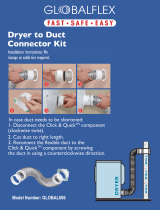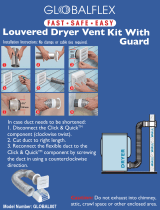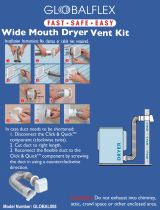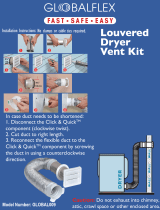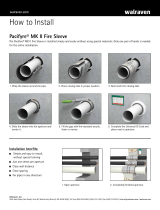Page is loading ...

OPERATING INSTRUCTIONS
Description
Installation
Operation
Title
FW100
Dust Concentration Monitor

Document Information
Described Product
Product name: FW100
Document ID
Title: Operating Instructions FW100
Part No.: 8008905
Version: 1.1
Release: 2012-12
Manufacturer
SICK AG
Erwin-Sick-Str. 1 · 79183 Waldkirch · Germany
Phone: +49 7641 469-0
Fax: +49 7641 469-1149
E-mail: info.pa@sick.de
Place of Manufacture
SICK Engineering GmbH
Bergener Ring 27 · 01458 Ottendorf-Okrilla · Germany
Trademarks
IBM is a trademark of the International Business Machine
Corporation.
MS-DOS is a trademark of the Microsoft Corporation.
Windows is a trademark of the Microsoft Corporation.
Other product names used in this document may also be trade-
marks and are only used for identification purposes.
Original Documents
The English edition 8008905 of this document is an original docu-
ment of SICK AG.
SICK AG assumes no liability for the correctness of an unauthor-
ized translation.
Please contact the manufacturer or your local representative in
case of doubt.
Legal information
Subject to change without notice.
© SICK AG. All rights reserved.
2 8008905 · © SICK AG
Subject to change without notice

Operating Instructions FW100
Dust Concentration Monitor
Contents
Notes on this Document ....................................................................................................7
1 Safety Instructions...............................................................................................................
8
1.1 Intended Use .............................................................................................................................8
1.2 Authorized Personnel.........................................................................................................
.....8
1.3 Safety Information and Protection Measures.................................................................8
1.3.1 Danger from Electrical Equipment ................................................................................................. 9
1.3.2 Danger due to Hot, Corrosive, or Pressurized Gases ............................................................ 9
1.3.3 Danger due to Laser Beam....................................................................................................
........... 9
1.3.4 Purge-Air Failure .............................................................................................................
....................... 9
1.3.5 Detecting and Preventing Malfunctions .................................................................................... 10
1.3.6 Shutdown, Removal from Service, and Storing System Components........................... 10
2 Product Description.......................................................................................................... 11
2.1 Features and Applications ................................................................................................. 13
2.2 Operating Principle and Measured Va
riables .............................................................. 14
2.2.1 Operating Principle ............................................................................................................................ 14
2.2.2 Response time ................................................................................................................................... 15
2.2.3 Check Cycle......................................................................................................................
.................... 15
2.3 Device Components............................................................................................................. 18
2.3.1 Transmitter/Receiver Unit .............................................................................................................. 18
2.3.2 Assembly Elements for Transmitter/Receiver Units ............................................................. 21
2.3.3 Connection Unit .............................................................................................................
.................... 22
2.3.4 External Purge-Air Unit (Optional) ........................................................................................
........ 24
2.3.5 Adapter fpr Instrument Air Supply................................................................................................ 24
2.3.6 Data Acquisition, Communication, Measured Value Output, and Display Options.... 25
2.3.7 ASC Option.................................................................................................................
........................... 26
2.3.8 Elbow Plug..................................................................................................................
........................... 26
2.3.9 Check Filter Set for FW100....................................................................................................
........ 26
2.4 Device Configuration ........................................................................................................... 27
2.5 Technical Data ..............................................................................................................
........ 28
Subject to change without notice
8008905 · © SICK AG 3

FW100 Operating Instructions
Dust Concentration Monitor
2.6 Dimensions and Order Numbers....................................................................................... 30
2.6.1 Transmitter/Receiver Unit .............................................................................................................. 30
2.6.2 Flange with Pipe.............................................................................................................
..................... 31
2.6.3 Tri-Clamp• Flange............................................................................................................................. 31
2.6.4 Connection Unit..............................................................................................................
..................... 32
2.6.5 External Purge-Air Unit (Optional) ........................................................................................
........ 33
2.6.6 Weatherproof Cover for Transmitter/Receiver Unit .............................................................. 34
3 Assembly and Installation...............................................................................................35
3.1 Project Planning .................................................................................................................... 37
3.2 Assembly .......................................................................................................................
.......... 28
3.2.1 Installing the Assembly Elements for the Transmitter/Receiver Units ........................... 38
3.2.2 Installing the Connection Unit ...............................................................................................
........ 40
3.2.3 Installing the Optional External Purge-Air Unit ........................................................................ 41
3.2.4 Fitting the Weatherproof Covers ................................................................................................
.. 42
3.3 Installation............................................................................................................................... 43
3.3.1 General Instructions and Prerequisites ....................................................................................43
3.3.2 Connection Unit .................................................................................................................................. 43
3.3.3 Connecting/Commissioning the Optional External Purge-Air Unit ................................... 45
3.3.4 Installing the Purge-Air Supply ...............................................................................................
........ 46
3.3.5 Connecting optional Devices ........................................................................................................ 48
4 Commissioning and Parameterization ........................................................................51
4.1 Basics ....................................................................................................................................... 53
4.1.1 General Notes .................................................................................................................................... 53
4.1.2 Prerequisites ..................................................................................................................
..................... 53
4.2 Installing and Connecting the Transmitter/Receiver Unit....................................... 54
4.2.1 Aligning the Transmitter/Receiver Unit....................................................................................... 54
4.2.2 Starting up the Transmitter/Receiver Unit ................................................................................ 55
4.3 Connecting the Device........................................................................................................56
4.4 Parameterization ................................................................................................................
... 57
4.4.1 Customer-Specific Parameterization........................................................................................... 57
4.4.2 Calibration for Dust Concentration Measurement................................................................. 59
4.4.3 Filter Bag Control ...........................................................................................................
..................... 60
4.4.4 Data backup ........................................................................................................................................ 62
4.4.5 Starting Standard Measuring Mode............................................................................................
63
4.5 Parameterizing Optional Devices ................................................................................... 64
4.5.1 Data Memory / Event Memory ..................................................................................................... 64
4.5.2 CAN Module ......................................................................................................................................... 67
4.5.3 Second Analog Output .......................................................................................................
.............. 68
4.5.4 LCD .........................................................................................................................
................................. 68
4.5.5 ASC Option............................................................................................................................................ 69
4 8008905 · © SICK AG
Subject to change without notice

Operating Instructions FW100
Dust Concentration Monitor
5 Maintenance....................................................................................................................... 71
5.1 General ..................................................................................................................................... 73
5.2 Maintaining the Transmitter/Receiver Unit
.................................................................. 74
5.2.1 Cleaning the Transmitter/Receiver Unit (Externally) ............................................................. 74
5.2.2 Cleaning the Optical Boundary Surfaces................................................................................... 74
5.3 Maintaining the Purge-Air Supply .................................................................................... 76
5.3.1 Connection Unit with Integrated Purge-Air Supply ................................................................. 77
5.3.2 External Purge-Air Unit (Optional) ................................................................................................. 78
5.4 Removal from Service.......................................................................................................... 79
6 Troubleshooting................................................................................................................. 81
6.1 Malfunctions........................................................................................................................... 83
6.2 Warnings and Malfunction Messages .......................................................................... 84
6.2.1 Warnings................................................................................................................................................ 84
6.2.2 Malfunction Messages.......................................................................................................
.............. 85
6.2.3 Other Malfunctions and Abnormal Behavior............................................................................ 87
6.3 Removal of Malfunctions.................................................................................................... 88
6.3.1 Adjusting the Laser Beam............................................................................................................... 88
6.3.2 Checking the Laser Beam for free Transit (FW101) ............................................................ 89
6.3.3 Checking the FW101 Receiver Optics for Correct Movement ......................................... 90
6.4 Test and Diagnosis Options............................................................................................... 91
6.4.1 Testing the Signal Output ................................................................................................................ 91
6.4.2 Check Cycle......................................................................................................................
.................... 91
6.4.3 Linearity Check.................................................................................................................................... 92
7 Repairs.................................................................................................................................. 93
7.1 Transmitter/Receiver Unit.................................................................................................. 96
7.1.1 Replacing the Cover and/or Protection tube (FW101)........................................................ 96
7.1.2 Replacing the Sintered Metall Flter (FW101).......................................................................... 96
7.1.3 Replacing the Entire T/R Unit Connector................................................................................... 96
7.1.4 Checking/Replacing the Battery for the Transmitter/Receiver Unit
................................ 98
7.2 Connection Unit..................................................................................................................... 99
7.2.1 Connection Unit without Purge-Air Supply................................................................................. 99
7.2.2 Connection Unit with Integrated Purge-Air Supply ...............................................................101
7.2.3 Replacing the LCD Module .....................................................................................................
......103
Subject to change without notice
8008905 · © SICK AG 5

FW100 Operating Instructions
Dust Concentration Monitor
8 Parts Overview.................................................................................................................105
8.1 Standard Components.......................................................................................................107
8.1.1 Transmitter/Receiver Units.......................................................................................................... 108
8.1.2 Assembly Elements .............................................................................................................
........... 108
8.1.3 Connection Units............................................................................................................
.................. 109
8.1.4 External Purge-Air Units (Optional) ........................................................................................... 109
8.1.5 Miscellaneous.................................................................................................................
.................. 109
8.2 Options ...................................................................................................................................110
8.2.1 Transmitter/Receiver Units.......................................................................................................... 110
8.2.2 Connection Units.............................................................................................................................. 110
8.2.3 Weatherproof Covers ........................................................................................................
........... 111
8.2.4 Accessories for Testing the Device..........................................................................................
111
8.2.5 Miscellaneous .................................................................................................................................. 111
8.3 Consumable Parts for 2-Year Operation......................................................................111
8.3.1 Transmitter/Receiver Units.......................................................................................................... 111
8.3.2 Connection Unit with Internal Purge-Air Supply.................................................................... 111
8.3.2 External Purge-Air Unit (Optional) .........................................................................................
..... 111
8.4 Spare Parts............................................................................................................................112
8.4.1 Transmitter/Receiver Unit ............................................................................................................ 112
8.4.2 Connection Unit..............................................................................................................
.................. 112
8.4.3 Miscellaneous .................................................................................................................................. 112
9 Appendix............................................................................................................................113
9.1 Standard Settings for the FW100..................................................................................115
9.1.1 FW101................................................................................................................................................. 115
9.1.2 FW102.........................................................................................................................
........................ 116
9.2 Password ...............................................................................................................................117
6 8008905 · © SICK AG
Subject to change without notice

Operating Instructions FW100
Dust Concentration Monitor
Notes On This Document
Notes On This Document
These operating instructions describe the functioning of the FW100 opto electronic dust
concentartion monitor in both variations FW101 and FW102. They serve for understanding
the device function and contain general information on planning, assembly, installation,
commissioning, maintenance, and troubleshooting. The description of the available device
components is intended to help you during the planning phase to determine the optimum
configuration for the particular application.
These operating instructions only cover standard ap
plications that conform to the technical
data listed. Your SICK representative will be glad to provide you with additional information
and support for special applications. We strongly advise that you contact a SICK specialist
for consultation on special applications.
Note • Always
read these operating instructions carefully before commencing work. The safety
instructions and warnings must be followed at all times.
• Some syst
em components (such as the side-channel compressor of the purge-air units)
are supplied with separate user information. This information must also be read carefully.
Symbols used in this document
For quick access and reasons of clarity, important safety inform
ation is specially highlighted
in these operating instructions. They are provided at the relevant points in the chapters.
Note Provides information on the features of the device o
r system, along with additional tips.
ATTENTION
Important
Indicates a risk of damage to the device or system components and potential functional
impairments.
DANGER
Warning
Identifies potential danger for personnel, particularly due to electrical equipment or as a
result of incorrect handling of the device or system components. These warnings are
intended to protect you from (fatal) injuries.
Always read warnings carefully and follow them at all times!
Subject to change without notice
8008905 · © SICK AG 7

FW100 Operating Instructions
Dust Concentration Monitor
Safety Instructions
1 Safety Instructions
1.1 Intended Use
The FW100 measuring system is used for measuring the dust concentration in exhaust
gases and waste air ducts. It must only be operated in the manner intended by the
manufacturer and in accordance with the following information. In particular, it is important
that:
• T
he system is operated in accordance with the technical data and specifications
regarding assembly, connection, ambient, and operating conditions (see the
documentation supplied, the order documents, device documents, and rating plates)
• All o
f the measures required to maintain the device, for example, for maintenance and
inspection requirements, are provided.
1.2 Authorized Personnel
Those responsible for personal safety must ensure that:
• All wo
rk on the measuring system is carried out by qualified personnel and checked by
the experts responsible.
These persons must be qualified by virtue
of their expertise (training, education,
experience) or understanding of the relevant standards, specifications, accident
prevention regulations, and properties of the system. It is crucial that these persons be
able to identify and avoid potential hazards in good time.
Technical experts are those persons defined in D
IN VDE 0105, IEC 364, or other directly
equivalent standards.
• Th
ese persons must be familiar with the hazards posed during operation, such as those
caused by hot, toxic, or pressurized gases, gas/liquid mixtures, or other media, and must
have received special training on how to operate the measuring system.
1.3 General Safety Information and Protection Measures
Handling or using the device incorrectly can result in personal injury or material damage.
Read this chapter carefully and ensure that you observe the safety precautions for the
FW100 at all times. Always observe the warnings provided in these operating instructions.
The following applies at all times:
• T
he relevant legal stipulations and associated technical regulations must be observed
when preparing and carrying out work on the installation.
• All work must be car
ried out in accordance with the local, system-specific conditions and
with due consideration paid to the operating dangers and specifications.
• T
he operating instructions for the measuring system and plant documentation must be
available on site. The instructions for preventing danger and damage contained in these
documents must be observed at all times.
• Suitable
safety equipment and personal protection measures must be available in
accordance with the potential hazard and must be used by the personnel.
8 8008905 · © SICK AG
Subject to change without notice

Operating Instructions FW100
Dust Concentration Monitor
Safety Instructions
1.3.1 Danger from Electrical Equipment
The FW100 measuring system is an item of electrical equipment designed for use in
industrial po
wer installations. When working on power connections or on live components,
make sure that the power supply is switched off. If necessary, replace shock protection
measures before reconnecting the power supply.
1.3.2 Danger Due to Hot, Corrosive, or Pressurized Gases
The transmitter/receiver unit is mounted directly on the gas-carrying
duct. In installations
with a low hazard potential (no risk of injury, ambient pressure, low temperatures, no risk of
explosion), this unit can be installed and removed while the installation is in operation,
provided that the applicable specifications and safety regulations for the installation are
adhered to and all necessary and suitable protective measures are taken.
DANGER
Warning
Installations with toxic gases, high temperatures, high pressure, or risk of explosion must be
shutdown before these components are installed or removed!
1.3.3 Danger Due to Laser Beam
WARNING
The FW100 uses a laser with laser class 2. To prevent blinding:
‡ Never look directly into the laser beam.
‡ Do not direct the FW100 laser beam towards people.
‡ Take into account reflections of the laser beam.
1.3.4 Purge-Air Failure
The purge-air supply protects the transmitter/receiver unit fitt
ed in the duct against hot or
corrosive gases. It must remain switched on when the plant is shut down. A purge-air supply
failure can quickly destroy the transmitter/receiver unit. For this reason, the operator must
ensure that:
ATTENTION
‡ The purge-air supply operates reliably and without interruption.
‡ A failure is detected immediately (for e
xample, by using pressure monitors).
‡ The transmitter/receiver unit is rem
oved from the duct in the event of a purge-air failure
and the duct openings are covered (for example, with a flange cover).
Subject to change without notice
8008905 · © SICK AG 9

FW100 Operating Instructions
Dust Concentration Monitor
Safety Instructions
1.3.5 Detecting and Preventing Malfunctions
Any deviations from normal operation must be
regarded as a serious indication of a
functional impairment. These include:
‡ Significant drifts in the measurement results
‡ A rise in power consumption
‡ A rise in system component temperature
‡ Actuating of monitoring devices
‡ Unusually strong vibrations / unusual operating noise from a purge-air fan
‡ Smoke or unusual odors.
1.3.6 Shutdown, Removal from Service, and Storing System Components
The FW100 measuring system must remain switche
d on when the plant is shut down. The
purge-air supply must never be switched off.
If the FW100 operating voltage is switched off for a prolonged period (m
ore than 3 days),
all the device components must be disassembled and stored in a dry, dust-free location.
10 8008905 · © SICK AG
Subject to change without notice


Operating Instructions FW100
Dust Concentration Monitor
Product Description
2 Product Description
2.1 Features and Applications
The FW100 series from SICK is designed to conduct continuous measurements of very low
(0.1 mg/m
3
) to medium (200 mg/m
3
and higher) dust concentrations in gases (temperature
above dew point). These measuring devices can be used in a wide range of application and
feature by low installation effort and simple handling.
System features and advantages
• High re
solution and measuring speed
• Me
asuring of the dust content independent of height and fluctuations of the gas velocity
• No
influence of moisture or charge of the particles
• De
fined zero point
• Ea
sy to install, no mechanical adjustment required
• No
calibration to dust-free measuring path required
• Si
mple operation and configuration with user-friendly software
• Aut
omatic check cycle
• Aut
omatic compensation of contaminations (type FW101)
• Minimum maintenance
requirements.
Application range
Applications ‡ In pure gas, downstream of electrostatic precipitators
– Continuous measurement and monitoring of du
st concentrations
– Protection of flue gas desulfurization plants
‡ In pure gas, downstream of modern fabric filters
– Monitoring, detection, and identification of defective filters and bags
– Prevention of the release of expensive production materials and toxic cont
ents in
continuous processes
‡ For monitoring and/or closed-loop control purp
oses in exhaust/intake air systems
Sectors • Power supply:
Power stations, heating systems
• Waste
disposal: Refuse incineration plants
• P
rocess engineering: Grinding and metering plants
• M
etal processing: Steel and aluminum processing
• F
oodstuff industry: Filling bulk materials
• Brake linings and Et
ernit production
Compliance The measurement system is approved according to F
ederal German Pollution Control Act
(13th, 17th and 27th Implementing Ordinance) and German Clean Air Regulations, an-
nounced in GMBL 2000, no. 60, pg. 1192.
Subject to change without notice
8008905 · © SICK AG 13

FW100 Operating Instructions
Dust Concentration Monitor
Product Description
2.2 Operating Principle
2.2.1 Operating Principle
The FW100 operates according to the scattered
light measurement principle (forward
scattering). Since it is extremely sensitive, this principle is particularly suitable for measuring
very small particle concentrations.
A laser diode directs a beam of modulated light i
n the visible range (wavelength approx.
650 nm) at the dust particles in the gas flow. The light scattered by the particles is recorded
by a highly sensitive detector which is positioned in an angle of approx. 15 ° to the beam
axis. The received signal is electrically amplified and supplied to the measuring channel of a
microprocessor as the central part of the measuring, control and evaluation electronics. The
point of intersection between the transmitted beam and the receiver aperture defines the
measuring volume in the gas duct.
The transmitting power of the laser diode is contin
uously controlled by measuring a part of
the transmitted intensity with a microchip in the laser diode. This received signal is also
amplified and supplied to the monitor channel of the microprocessor. In this way lowest
brightness changes of the transmitted laser beam can be detected and take into account
in the determination of the output signal.
Fig. 2.1: FW100 Operating principle
The measured scattered light intensity is proportional to the dust concentration. Since the
scattered light intensity doesn't only depend on the particle number (dust content) but also
on the visual qualities of the particles, the FW100 must be calibrated with a gravimetric
comparison measurement to secure an exact measuring of the dust concentration. The
calibration coefficients determined at this measurement are entered in FW100 (see
Section. 4.4.2) in the form:
cc2: square
c
c1: linear
cc0: absolute
c=cc2
· SI² + cc1 · SI + cc0 c=Dust concentration
SI = Scattered light intensity
cc = calibration coefficiant
The manufacturer settings are cc2
= 0, cc1 = 1, cc0 = 0.
Transmitter/receiver unit
Laser diode
Gas duct
Detector
Measuring volume
14 8008905 · © SICK AG
Subject to change without notice

Operating Instructions FW100
Dust Concentration Monitor
Product Description
2.2.2 Response Time
The response time (t
90
) is the time taken by the FW100 to reach 90% of the end value after
a sudden change in the measured value (see Fig. 2.2). The t
90
time can be set to any value
between 0.1 and 600 s. Setting a higher t
90
time provides better attenuation of transient
fluctuations in the measured value and malfunctions to produce a "smoother" output signal.
Fig. 2.2: Response time
2.2.3 Check Cycle
The check cycle is used for automatically checking that the transm
itter/receiver is
functioning properly. The check cycle can be triggered automatically at fixed intervals
(setting in MEPA-FW, see Section 4.4.1) and/or manually (1 min after the power supply has
been connected, or the system has been switched fr
om "Maintenance" to "Measure" in
MEPA-FW).
The check values can be given out at the analog output (see Section 4.4
.1).
Notes • When the check values are bei
ng determined, the value last measured is given out at the
analog output.
• If th
e check values are not given out at the analog output, the current measured value is
given out once the check value has been determined.
• Th
e "Maintenance" relay is activated to signal that a check cycle is in process.
• With t
he LCD option, a check cycle is indicated with a plain-text "check cycle" display and
as a status output at relay 6.
• Aut
omatic check cycles are carried out periodically from the parameterized time interval.
A re-start begins if the interval setting is changed or 1 min after:
– Change from „Maintenance“ to „Measure“ mode
– Reset (power off/on)
– Switch-on of the power voltage after power failure.
Measured
value
in %
Measured value with t
90
response time
90 % of the peak
Process change
t
90
t in s
100
98
96
94
92
90
88
86
84
10 20 30 40 50 60 70 80 90 100
Subject to change without notice
8008905 · © SICK AG 15

FW100 Operating Instructions
Dust Concentration Monitor
Product Description
Check cycle FW101
If a check cyle is carried out, inadmissible dev
iations appearing by the normal behavior are
signaled as a malfunction. If a malfunction is present, you can trigger a check cycle manually
to locate the cause of the problem (see Chapter 6).
The check cycle lasts approx. 310 s and comprises:
The values are only given
ou
t to the analog output in
case of activation (see
Section 4.4.1).
• 40 s co
ntamination measurement of the optical boundary surfaces, zero and check value
• 90 s output
of the contamination value
• 90 s output o
f the check value
• 90 s output
of the zero value.
Fig. 2.3: FW101 check cycle output on plotter
Contamination
Measurement
In order to measure the contamination on the optical boundary surfaces, the FW101 moves
the receiver optics mechanically to a reference position. As a result, the optics measure the
light emitted by the laser diode directly. The intensity value measured during the movement
is compared with the factory settings to calculate a correction factor. In this way, the FW101
can fully compensate for any contamination levels.
If the contamination value is lower than 70 %, a analog value is given out
during the check
cycle in a range between Live Zero and 20 mA and proportional to the contamination value
(device status „Operation“). For contamination values higher than 70 % always Live Zero is
given out (device status „Malfunction“).
Fig. 2.4: FW101 contamination and check value measurement
Check Value
Measurement
(Span test)
Following to the contamination measurement, the check
value is determined (receiver
optics is in reference position). Once a reference measurement has been carried out with a
light intensity of 100 %, the FW101 reduces the intensity of the laser diode to 70 % and
compares the value measured by the receiver with the expected value. If these two value
deviate more than ±2 %, the device generates an error signal. The error message is lifted
a
gain if the next check cycle passes successfully.
Degree of
contamination
Check value (70 % value, span)
Zero value (Live Zero)
End
check cycle
Start
Check cyclecontamination
output
Zero value
output
Paper feed
Check value
output
Receiver optics in reference position
16 8008905 · © SICK AG
Subject to change without notice

Operating Instructions FW100
Dust Concentration Monitor
Product Description
Zero Value
Measurement
In order to monitor the zero point, the FW101 deactivates the laser diode, and the reception
signal must also be zero. In this way, drifts or zero-point eviations in the entire system (e.g.
caused by an electronic defect) can be reliably detected. If the “zero-value” deviation is out-
side the specified range, an error signal is generated.
Check cycle FW102
At the FW102, the measuring linearity is checked during a check cy
cle. The check cycle lasts
approx. 200 s and comprises a:
• 20 s measur
ement of zero and check value
The values are only given
out to the
analog output in
case of activation (see
Section 4.4.1).
• 90 s outp
ut of the check value
• 90 s outp
ut of the zero value.
Fig. 2.5: FW102 check cycle output on plotter
Check Value
Measurement
(Span test)
The FW102 measures the check point with the receiv
er optics in the measuring position.
During this time, the light intensity changes between 70 and 100%. Thanks to a large
number of intensity shifts, which are evaluated statistically, the FW102 enables the check
point to be measured with pinpoint accuracy (prerequisite: dust contents
> approx. 2 mg/
m³, otherwise the theoretically calculated 70 % value is given out.
The check value is evaluated in the same way as with the FW101 (error messages in case
of
deviations of more than ±2 %).
Zero Value
Measur
ement
The FW102 carries out a zero-point measurement in the same way with the FW101.
Start
Check cycle
Check value (70 % value, span)
Zero value
output
Output
check value
Zero value (Live Zero)
End
check cycle
Paper feed
Subject to change without notice
8008905 · © SICK AG 17

FW100 Operating Instructions
Dust Concentration Monitor
Product Description
2.3 Device Components
Device Variants
• F
W101 for use in gas ducts with a diameter greater than 250 mm.
The device is mounted on the duct using a fl
ange with tube.
• F
W102 for use in gas ducts with a diameter greater than 150 mm.
The FW102 can be mounted on a flange wi
th fitting (Tri-Clamp®) or a 1” sleeve on the
duct.
FW100 Components
Possible device configurations see section 2.
4.
• T
ransmitter/receiver unit
• F
lange with pipe / flange with fitting / 1” sleeve
• Connect
ion unit
– with integrated purge-air supply (for internal duct pre
ssure -70 ... +10 mbar)
– without purge-air supply. The following is, therefore, required:
• E
xternal purge-air supply (for internal duct pressure -70 ... +70 mbar)
Fig. 2.6 Overview of the FW100 components
Connection unit with
purge-air supply
Connection
unit without
purge-air
supply
External purge-air
unit option
Transmitter/receiver unit
Purge-air hose
Signal cable
MEPA-FW
operating and
configuration
program
Flange with pipe
RS 232
Power supply
Duct
Optional
18 8008905 · © SICK AG
Subject to change without notice

Operating Instructions FW100
Dust Concentration Monitor
Product Description
2.3.1 Transmitter/Receiver Unit
The transmitter/receiver unit consists o
f two main modules:
• E
lectronic unit
It contains the optical and electronic modules for
transmitting and receiving the light be-
am, as well as processing and evalu
ating signals.
• Meas
uring probe
The measuring probe is designed in different forms,
nominal lengths and for different gas
temperature ranges and defined the device variant.
The transmitter/receiver unit is connected to t
he connection unit using a 16-pole cable with
a connector, and has a 24 V d.c. power supply. Clean purging air is supplied to a purge-air
nozzle to cool the probe and keep clean the optical boundary surfaces.
FWSE101 Transmitter/Receicer Unit
The transmitter/receiver units are availabl
e in the following versions:
Fig. 2.7: FWSE101 transmitter/receicer unit nominal length 435 / 735 mm
Nominal length
NL in mm
max. Gas
temperature
in °C
Protection tube Use for
Length L in mm Material
435
220
300
Stainless steel
Hastelloy Corrosive gases
400 Stainless steel
735
220
600
Stainless steel
Hastelloy Corrosive gases
400 Stainless steel
1035
220
900
Stainless steel Wall and isolation thick-
ness up to 720 mm
400 Stainless steel
1335
220
1200
Stainless steel Wall and isolation thick-
ness up to 1020 mm
400 Stainless steel
Electronic unit
Probe head
with receiver
optics
Purge-air nozzle
Purge-air outlets at high temperature
version (HT) up to 400 °C
Cleaning opening for transmitter optics
NL
Connector for signal cable
L
(Flange with pipe)
(Duct wall)
Protection tube
Measuring
opening
Subject to change without notice
8008905 · © SICK AG 19

FW100 Operating Instructions
Dust Concentration Monitor
Product Description
Fig. 2.8 FWSE101 transmitter/receicer unit nominal length 1035 / 1335 mm
Notes • Transmitter/receiver units with nominal length > 735 mm are exclusive scheduled for the
installation in thick-wall or double walled ducts with wall and isolation thickness of approx.
400 mm to 1020 mm.
• T
he distance between inside duct wall and measuring opening may be max. 450 mm
(see Fig. 2.8).
FWSE102 Transmitter/Receicer Unit
The following versions are available:
Fig. 2.9: FWSE102 1“ transmitter/receicer unit (NL 280 mm is shown)
Cleaning opening for transmitter optics
NL
(485 mm)
Laser with drive electronics in housing
(must be within the channel wall/isolation)
max. 450 mm
(Duct wall/isolation)
L
Nominal length NL
in mm
Mounting type Duct diameter
in mm
180
1“ sleeve
> 150
Flange with fitting (Tri-Clamp®)
280
1“ sleeve
Flange with fitting (Tri-Clamp®)
Purge-air nozzle
Connector for signal cable
Cleaning opening for transmitter optics
NL
Electronic unit Measuring probe
Probe head with
receiver optics
1“ thread
20 8008905 · © SICK AG
Subject to change without notice
/

